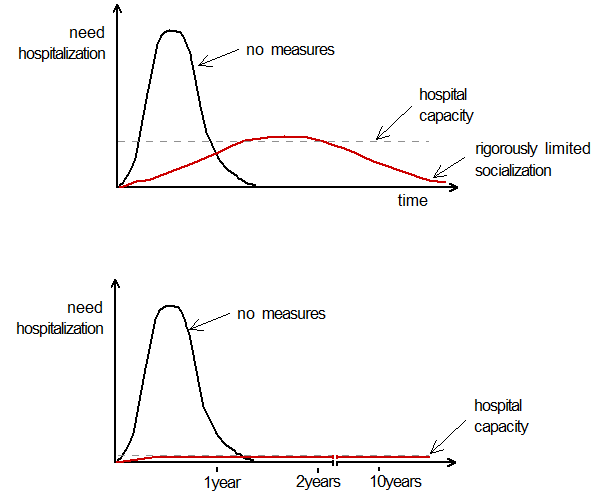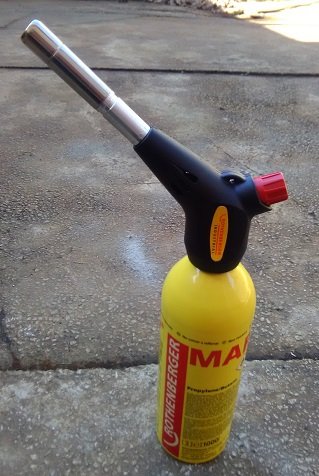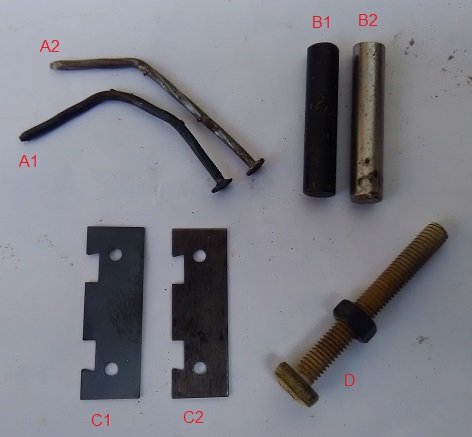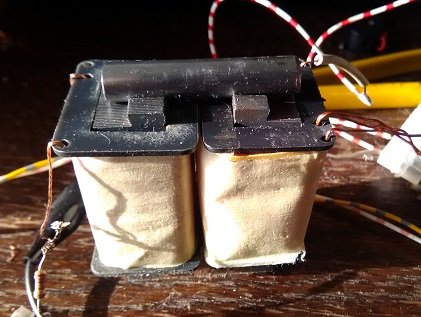

Danijel Gorupec
Senior Members-
Posts
714 -
Joined
-
Last visited
-
Days Won
2
Content Type
Profiles
Forums
Events
Everything posted by Danijel Gorupec
-

Corona virus general questions mega thread
Danijel Gorupec replied to FishandChips's topic in Microbiology and Immunology
Hmm... Wikipedia says: "Coronavirus disease 2019 (COVID-19) is an infectious disease caused by severe acute respiratory syndrome coronavirus 2 (SARS-CoV-2)" https://en.wikipedia.org/wiki/Coronavirus_disease_2019 That would mean that COVID-19 is the name of the illness (or disease, is this the same?), while SARS-CoV-2 is the name of the virus. (bad names, if you ask me - I guess, intentionally bad names) -

Corona virus general questions mega thread
Danijel Gorupec replied to FishandChips's topic in Microbiology and Immunology
Me again... Is there a specific term for number of viral particles (viral load) one receives during exposure? I read that it might influence the severity of a viral disease - is this like a rule or holds only for some diseases? Or it just affect the delay in onset of symptoms, not the eventual severity? (Well ok, if one gets rabies then the eventual severity is invariably the same. I am asking about diseases more like this corona stuff. ) -

Corona virus general questions mega thread
Danijel Gorupec replied to FishandChips's topic in Microbiology and Immunology
Thanks. Another thing... I cannot find any data about the increase in total number of deaths (whatever is the name for it). For example, I calculated that in Italy, on an usual day without pandemic, there should be about 2000 deaths. Now, in times of pandemic, they report 600-700 deaths due to virus only. But I cannot find if the total number of deaths is just the sum, or less (or even more) than this. Anyone of you have some idea? -

Corona virus general questions mega thread
Danijel Gorupec replied to FishandChips's topic in Microbiology and Immunology
You mean like general population health? -

Corona virus general questions mega thread
Danijel Gorupec replied to FishandChips's topic in Microbiology and Immunology
I understand. Then, when everything is over, are we to expect relatively small difference in mortality between counties? If so, then the current number of deaths might be a better indicator than the number of confirmed cases to show how much is the disease spread in some country. On the other hand, if we are to expect large differences in mortality, what might be possible reasons to influence it so much? -

Corona virus general questions mega thread
Danijel Gorupec replied to FishandChips's topic in Microbiology and Immunology
Sorry, is you answer for transmission rate or mortality rate? -

Corona virus general questions mega thread
Danijel Gorupec replied to FishandChips's topic in Microbiology and Immunology
(Sorry for watering down the nice flame we had on this thread.) What is your opinion how can the reported mortality rate be so much different from country to county? -

Corona virus general questions mega thread
Danijel Gorupec replied to FishandChips's topic in Microbiology and Immunology
Thank you very much, Strange. Finally a discussion I was looking for (funny, but I find it to be a relief - At least I know that other people are aware of the issue, I felt alone until now). -

Corona virus general questions mega thread
Danijel Gorupec replied to FishandChips's topic in Microbiology and Immunology
I know this... when I said that 5000 new cases per day, I didn't mean that all 5000 will end in hospitals. I meant that from 5000 new cases, the number of hospitalized is already overwhelming the Italian hospital system. (Also, my calculation of 11 years of quarantine is based on 20M people, not all 60M Italians). Nobody commented how long we can cope with heavy measurements like currently forced in Italy. They show us the first graph, but it seems that reality is more like the second graph. Hospitals have much lower capacity than I ever thought, so measures must be rigorous to keep such a low number of new cases. My government forbade me to do my work - I guess they are planning to sell monetary reserves and maybe even print money. But this are all mid-term solutions. The long term solution is to let me work again, but then how they plan to keep the number of new cases low enough for the surprisingly weak hospital system. As I said, I see no actual plan. -

Corona virus general questions mega thread
Danijel Gorupec replied to FishandChips's topic in Microbiology and Immunology
No. -

Corona virus general questions mega thread
Danijel Gorupec replied to FishandChips's topic in Microbiology and Immunology
So, this is it - Italian government' plan is to wait for vaccine? I wonder if we already have any vaccine for viruses in this family? -

Corona virus general questions mega thread
Danijel Gorupec replied to FishandChips's topic in Microbiology and Immunology
I don't see the actual plan. Governments are trying to slow-down the spreading to ensure the medical system will not become overwhelmed. But my guestimation numbers say it can cannot be the way.... take for example Italy. It seems that Italy cannot handle more than 5000 new cases per day. More than this overwhelms hospitals. There are 60 million people in Italy.... If government enforces severe restrictions to keep new cases under 5000, it will take 4000 days (11 years) until 1/3 of population obtains the immunity. But Italy cannot stand 11 years of quarantine. So what is the actual plan? a) To increase the capacity of hospitals so that the daily limit of new cases can be increased to 50000? Yes, it can be done in less than 11 years, but quite difficult now, under 'fire'. b) To wait and hope for a vaccine or a cure? Can this be called a plan at all? -

Coffee filters as face masks?
Danijel Gorupec replied to Enthalpy's topic in Microbiology and Immunology
Sorry, but I must viciously comment... Okay, they forget to secure masks for medical personnel on time. Sounds like a beginners mistake, but fine. It happens... But then asking people not to buy masks because "it won't serve you, but will certainly serve us" sounds really naive. -

COVID-19 antivirals and vaccines (Megathread)
Danijel Gorupec replied to Alex_Krycek's topic in Microbiology and Immunology
I didn't know that it works for viruses too. Anyone knows the mechanism? (Then again, I know that silver kills werewolves.) -

Corona virus general questions mega thread
Danijel Gorupec replied to FishandChips's topic in Microbiology and Immunology
Does it mean that Spanish flu mortality would be much lower if better symptomatic treatment was available? -

Coffee filters as face masks?
Danijel Gorupec replied to Enthalpy's topic in Microbiology and Immunology
Sure. But it can also be a clever way to make those that have the virus (and might not know it) to cover themselves. Anyhow, I think that when people seek guidance, they will find it. So it is better for government to give some advice (even if it is a sugared water) than to delay making a decision and risking that people start looking for guidance in other direction. -

Coffee filters as face masks?
Danijel Gorupec replied to Enthalpy's topic in Microbiology and Immunology
Well.. the primary property of a face mask is that you can still breathe. If coffee filters allow it, I guess it would make good temporary solution. Then again, I guess, few layers of most cloth would be better than nothing. In what way? Like not changing it regularly or something else? -
1. Yes, the material must be ferromagnetic. In practice, it means steel (mild steel, more specifically). Other ferromagnetic materials exist, but are harder to obtain. Mild steel, on the other hand, is very common - nails, bolts and many other things. Generally, lower the carbon content in the steel, better its magnetic permeability. Pure iron (like 99.95% pure) would be very good, but you won't find it. Most steel will have like 0.2% carbon or more... Some specifically made alloys can also have very good magnetic properties - like electrical steel (silicon steel). You can find this inside transformers, but you might be disappointed because you will find it in form of thin sheets. Better material (higher magnetic permeability) can make better electromagnets, but it only pays so much to obtain it. It won't have superpowers. You can easily check if a material is ferromagnetic - if a magnet sticks to it it is ferromagnetic and will make an electromagnet. (Brass, copper, bronze, aluminum, and most stainless steel are NOT ferromagnetic). 2. Yes, you can wrap wire around any ferromagnetic material and it will show some magnetic effect. You might be disappointed with the oven pan - as it will make a weak electromagnet. If you make a thin and wide plate and wrap a wire around its perimeter, the effect will be small. Magnetic field lines must close themselves, and if your plate is wide they must go long way all around the plate to the other side - if you force magnetic field lines to 'travel' long way through the air it is hard to make them strong (dense, actually). The magnetic field is the 'happiest' if it can travel through iron most of the time and only make short jumps over the air. A better design would be if you make many small electromagnets (wire around a short bolt) and arrange them side-by-side in a plane to make a plate. You must orientate every other one into the opposite magnetic direction. Magnetic filed lines will 'run' through them from one side to the other side of the plate, taking only short jumps over the air. 3. In addition to the magnetic permeability of the ferromagnetic material, and in addition to the length the magnetic field lines must travel (as said, especially critical is how far they travel through air or other non-ferromagnetic paths), the strength of the electromagnet will be governed by ampere-turns. That is, current in the wire current multiplied by the number of the wire turns. You can choose appropriate wire gauge to adjust the electromagnet to your battery. With thinner wire you will be able to make more wire turns and its resistance will be greater. The current will be smaller (when connected to the battery of some voltage) and the battery will last longer. Of course, a wire can take only so much current so there are limits. Another limit is the ferromangetic material itself - it will only 'allow' magnetic field up to certain strength (in practice, some 1.5 tesla - but you will have hard time to reach even this). All said above is for simple case of DC powered electromagnets (battery). For AC powered electromagnets (or electromagnets where activation/deactivation time is critical), things get more complicated.
-
Maybe you can take a look at Math-o-mir (google for it). It allows free math writing, but does require some practice.
-
Just my opinion... I think cell (prokaryotic, eukaryiotic) is certainly alive. Boundaries between superstructures built from cells don't seem so sharp to me - so I don't really see why we wouldn't call an ecosystem alive if we already call an organism alive. Both are is just a bunch of living cells coexisting together. You might say, for example, that a human cell cannot live without the rest of the human organism. But it does not mean that the cell is not alive - it merely means that the cell cannot survive out of its 'ecosystem' (human body)... What makes the cell alive, in my opinion, is that it is capable to maintain its own internal complexity taking only simpler ingredients from its surrounding. I know how foggy it sounds. I always felt that a proper definition of life has to have something to do with maintaining local complexity (despite the odds of natural randomization). I was however never capable to produce a sharp definition. Regarding the OP: I would never say the planet Earth is alive. But I might be prone to say that global Earth's ecosystem is alive. Somebody mentioned fire: I wouldn't call fire alive... Hmm, is it more complex than the fuel it consumes? If yes, I must admit I would be pressed to explain why not. Virus (not alive), imo, does not reproduce itself. It is being reproduced.
-
If anyone interested... I went to a store and bought a torch - spent more than I expected (cca 70EUR; 75USD - one fuel bottle included). I took the most powerful torch of this type they had. It proved very capable, so maybe I could choose a cheaper one. They call the fuel the "MAPP gas". I understand this is some propylene - butane mixture. Hotter than butane, they say. So, I filled a shallow steel pot with dried crushed stones (angular rock 5-10mm), because I didn't have anything better. Placed steel pieces onto the rock and heated it with the torch. Btw, while heating, the surrounding rock also becomes red-hot (at surface). Interestingly, some gray (granite-like color) rock pieces turned white after this heat treatment. I kept the metal dark-red-hot for about one minute, and then using pliers transferred it into different pot full of wood-ash (I didn't have anything else, but I read that wood-ash is a good choice). Buried inside the ash the metal cooled slowly enough, I hope. I annealed following items: a small nail, M5 screw with a nut, a short bright-drawn steel rod, few pieces of transformer lamination (silicon steel) Results: To check if I am doing anything good, I compared the annealed nail (sample A1) with an identical non-annealed nail (sample A2). I was surprised how much easier it is to bend the annealed nail. I could bend it with fingers (the smaller bend on the A1 sample is done with fingers only; the larger bends on both samples are made with a help of a vise). Must be I am doing something right. To check dimensional stability, I annealed a screw with a nut on it (sample D). Unwisely, I choose a coated screw (a bright coating - is this nickel or what?). This coating turned green during heat treatment, so it was less easy to monitor the temperature of the sample. The nut, being smaller, become dark-red-hot much faster than the screw (obviously, there was not that much heat transfer between the nut and the screw).... After the cooling, it was equally easy to turn the nut as before annealing - so I suppose, the dimensional stability is good enough. The nut did not weld itself to the screw. The bright-drawn mild-steel bar sample (B1) - fi 8mm x 36mm - turned dark (after cooling). It looked more like a hot-drawn or hot-rolled steel. You can see it in comparison with the non-annealed sample B2. Electrical steel lamination (sample C1) has large surface - so I was afraid it might cool to fast. The sample C2 is not annealed. Not much difference between the two. Magnetic measurements: I broke the core of a small transformer (old one, low-quality one - there is no insulation between lamination layers) - I arranged it so that I can place metal samples to close magnetic circuit. Look at the picture: the sample B2 is placed into the measurement position (I would also place a weight of non-magnetic material onto the sample during actual measurement). I am pushing sine-wave current, of constant amplitude, into one coil and then measuring voltage in the other coil. The setup has very bad sensitivity because there is large magnetic reluctance in the gap between sample and transformer core (I guess, larger than the reluctance of the sample itself). Therefore I couldn't measure anything precisely. The results I obtained, are not entirely clear. With electrical steel, I measure no obvious difference. If there is any difference, the non-annealed electrical steel is better than annealed one. The non-annealed electrical steel sample gives about 5% more measured voltage than annealed sample (but measurement error might be larger than that). In addition, annealed electrical steel does not seem any easier to bend. So, no benefit from annealing electrical steel (or I don't know how to do it properly). I did however see some improvements with bright-drawn mild steel. The sample B1 produces higher measured voltage than the sample B2. The difference is larger at smaller flux densities (I don't know why - I don't think my sample reached saturation in any case). What surprised me even more is that that the difference is larger at higher frequencies (I would expect otherwise - puzzling). Excitation current 90mA, 20Hz: Sample B1 -> 7.5V; Sample B2 -> 6V (cca 25% difference in measurement) Excitation current 90mA, 80Hz: Sample B1 -> 27.5V; Sample B2 -> 20.5V (cca 34% difference in measurement)) Excitation current 300mA, 20Hz: Sample B1 -> 25.5V; Sample B2 -> 23.5V (cca 9% difference in measurement)) Excitation current 300mA, 80Hz, Sample B1 -> 90V, Sample B2 -> 77V (cca 17% difference in measurement))
-
But isn't processed food invented to decrease food waste?
-
Mostly for fun, I would like to try annealing some small steel pieces (say, half inch size or less). Tips? What would be most easily obtainable tools to do it? What kind of torch should be enough - or should I build a wire heater? They say: soak it at correct (red-heat?) temperature for some time (seconds, minutes?) and then slowly (how slowly?) cool it down. I guess such small peaces would cool to quickly in air? Some internet guys also say that you should not heat it too much (orange). I don't understand how can this be a problem?
-
Beautiful (expressing the g-factor as a ratio of two frequencies where frequencies can be measured very accurately). It does however seem to me that the method assumes certain confidence in equations - that is, that Larmor and cyclotron frequency formulas are both very linear in respect to B. It seems that spin angular momentum of electron is usually obtained indirectly by measuring magnetic moment and assuming that formulas are right. Still, I did find one example where spin seems to be measured more directly - wikipedia calls it Einstein-de Haas effect: https://en.wikipedia.org/wiki/Einstein–de_Haas_effect




